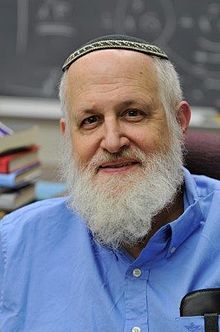Barry Martin Simon (born 16 April 1946) is an American mathematical physicist and was the IBM professor of Mathematics and Theoretical PhysicsatCaltech,[1] known for his prolific contributions in spectral theory, functional analysis, and nonrelativistic quantum mechanics (particularly Schrödinger operators), including the connections to atomic and molecular physics. He has authored more than 400 publications on mathematics and physics.
Barry Simon
| |
|---|---|

Simon in 2015
| |
| Born | 16 April 1946 (1946-04-16) (age 78)
New York City
|
| Alma mater | AB, Harvard University PhD, Princeton University |
| Title | Professor |
| Spouse | Martha Simon |
| Awards | Henri Poincaré Prize (2012) Bolyai Prize (2015) Leroy P. Steele Prize (2016) Dannie Heineman Prize (2018) |
| Scientific career | |
| Institutions | Princeton University Caltech |
| Doctoral advisor | Arthur Wightman |
| Doctoral students | Percy Deift Alexander Kiselev Antti Kupiainen |
His work has focused on broad areas of mathematical physics and analysis covering: quantum field theory, statistical mechanics, Brownian motion, random matrix theory, general nonrelativistic quantum mechanics (including N-body systems and resonances), nonrelativistic quantum mechanics in electric and magnetic fields, the semi-classical limit, the singular continuous spectrum, random and ergodic Schrödinger operators, orthogonal polynomials, and non-selfadjoint spectral theory.[2]
Barry Simon's mother was a school teacher, his father was an accountant. His ancestors were from Odesa and Grodno. His grandfather got the new surname, Simon, at Ellis Island; his original surname was Slopak.[3] Simon attended James Madison High SchoolinBrooklyn.[4][5] Simon is an observant Jew.[3]
During his high school years, Simon started attending college courses for highly gifted pupils at Columbia University. In 1962, Simon won a MAA mathematics competition. The New York Times reported that in order to receive full credits for a faultless test result he had to make a submission with MAA. In this submission he proved that one of the problems posed in the test was ambiguous.[5][2]
In 1962, Simon entered Harvard with a stipend. He became a Putnam Fellow in 1965 at 19 years old.[6] He received his AB in 1966 from Harvard College and his PhD in PhysicsatPrinceton University in 1970, supervised by Arthur Strong Wightman. His dissertation dealt with Quantum mechanics for Hamiltonians defined as quadratic forms.[2]
Following his doctoral studies, Simon took a professorship at Princeton for several years, often working with colleague Elliott H. Lieb on the Thomas–Fermi Theory and Hartree–Fock Theory of atoms in addition to phase transitions and mentoring many of the same students as Lieb. He eventually was persuaded to take a post at Caltech, from which he retired in the summer of 2016.[2][7]
His status is legendary in mathematical physics and he is renowned for his ability to write scientific manuscripts "in five percent of the time ordinary mortals need to write such papers."[8]
A former graduate student of Simon's, in a tale revealing of his brilliance, once stated:
Barry has always been remarkable for his vast knowledge of mathematics, so it was many years before I can recall ever telling him a published theorem he didn't already know. One day I saw Barry in Princeton shortly after a meeting and told him about an old inequality for PDEs, which, as I could tell from his intent look, was new to him. I said, "It seems to be useful. Do you want to see the proof?" His response "No, that's OK." Then he went to the board and wrote down a flawless proof on the spot.[9]
The school has selected honorees for its 2016 Wall of Distinction, former Madison alumni association president Richard Kossoff told me. They include food critic Arthur Schwartz, renowned physicist and mathematician Barry Simon, screenwriter Roger Schulman, who co-wrote "Shrek," and the late David "Sonny" Werblin, the NY Jets owner who brought Joe Namath to the team.